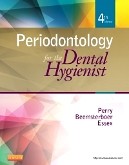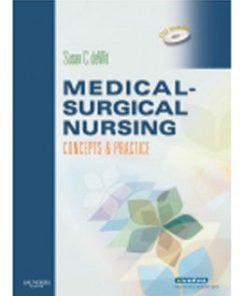Test Bank for Periodontology for the Dental Hygienist 4th Edition by Perry
$35.00 Original price was: $35.00.$26.50Current price is: $26.50.
Test Bank for Periodontology for the Dental Hygienist 4th Edition by Perry
Test Bank for Periodontology for the Dental Hygienist 4th Edition by Perry

Product details:
- ISBN-10 : 9781455703692
- ISBN-13 : 978-1455703692
- Author: Perry
Description:
Chapter 3: Epidemiology of Periodontal Diseases
MULTIPLE CHOICE
- Which plaque scoring system evaluates the amount of plaque at the gingival margin?
| a. | O’Leary Index |
| b. | Plaque Index of Silness and Löe |
| c. | Gingival Index of Löe and Silness |
| d. | Simplified Oral Hygiene Index of Greene and Vermillion |
ANS: B
The Plaque Index of Silness and Löe is designed to evaluate the quantity of plaque at the gingival margin.
PTS: 1
- Which index has both a debris and calculus index that can be combined for an oral hygiene index?
| a. | O’Leary Index |
| b. | Plaque Index of Silness and Löe |
| c. | Gingival Index of Löe and Silness |
| d. | Simplified Oral Hygiene Index of Greene and Vermillion |
ANS: D
The Simplified Oral Hygiene Index of Greene and Vermillion (OHI-S) has both a plaque and a debris index.
PTS: 1
- Which index uses a specially designed periodontal probe called the World Health Organization probe?
| a. | Sulcus Bleeding Index |
| b. | Russell’s Periodontal Index |
| c. | Periodontal Disease Index of Ramfjord |
| d. | Community Index of Periodontal Treatment Needs |
ANS: D
The Community Index of Periodontal Treatment Needs (CIPTN) has a specially designed probe for making measurements.
PTS: 1
- The 1987 national data on the oral health of United States adults showed that calculus is present in approximately:
| a. | One-fourth of all adults. | c. | One-half of all adults. |
| b. | One-third of all adults. | d. | Two-thirds of all adults. |
ANS: B
Calculus has been shown to be present on approximately one-third of adults.
PTS: 1
- Tobacco use is associated with increased levels of periodontal disease. It has multiple systemic effects that alter the inflammatory process.
| a. | Both statements are TRUE. |
| b. | Both statements are FALSE. |
| c. | The first statement is TRUE, and the second is FALSE. |
| d. | The second statement is FALSE, and the first is TRUE. |
ANS: A
Both statements are true. Tobacco has many effects on the immune system and its use is clearly linked to increased incidence of periodontal disease.
PTS: 1
Please use the description to answer the following questions.
In an epidemiologic study of periodontal disease, the dental hygienist identified a population of 100 individuals but could only select 50 for examination because of time and resource constraints. All individuals were to be examined within two weeks while they were visiting the local dental clinic. The dental hygienist planned to probe all teeth in each subject and set the definition of disease at 1 probe depth of 4 mm. The dental hygienist was also interested in identifying risk factors; therefore, subjects were questioned regarding age, socioeconomic status, and smoking status. Both men and women were to be included in the study and were in equal proportion in the population of 100.
- What kind of epidemiologic study is planned?
| a. | Cohort design | c. | Cross-sectional design |
| b. | Case-control design | ||
ANS: C
This is a small cross-sectional study of patients who came for treatment to this particular clinic.
PTS: 1
- When the data were collected on the 50 subjects, how broadly could the findings be generalized?
| a. | To all persons in the world |
| b. | To the population of America |
| c. | To the population living in the area |
| d. | To the 100 members of the larger group |
ANS: D
The results could be generalized to the population of 100 because the dental hygienist took a random sample for evaluation.
PTS: 1
- What is the best way to identify the 50 subjects from the population of 100?
| a. | Select every other individual. |
| b. | Randomly select 50 individuals. |
| c. | Examine the first 50 individuals. |
| d. | Select the first 25 females and the first 25 males. |
| e. | Place the individuals in alphabetical order and select every other person. |
ANS: B
Random selection provides an unbiased sample of patients.
PTS: 1
- What is the best way for the researcher to evaluate smoking among the population?
| a. | Ask everyone how much they smoke. |
| b. | Define smoking by a specified amount. Divide the group into smokers and nonsmokers. |
| c. | Include everyone who smokes or has ever smoked. |
ANS: B
Define smoking, and identify the group of smokers that meets the criteria.
PTS: 1
- Ten of the subjects in the study group met the criterion for having periodontal disease. The percent of the SAMPLE with periodontal disease was:
| a. | Ten of 50, or 20%. | c. | Ten of 10, or 100%. |
| b. | Five of 10, or 50%. | d. | Ten of 100, or 10%. |
ANS: A
20% of the sample of 50 subjects had periodontal disease.
PTS: 1
- The dental hygienist was able to generalize the results to the broader population. The percent of the population with periodontal disease was:
| a. | Ten of 50, or 20%. | c. | Ten of 10, or 100%. |
| b. | Five of 10, or 50%. | d. | Ten of 100, or 10%. |
ANS: A
20% of the population had periodontal disease.
PTS: 1
- Two of the individuals in the SAMPLE group with no evidence of periodontal disease SMOKED. What was the number in the sample who did NOT smoke and did NOT have periodontal disease?
| a. | 20 | c. | 38 |
| b. | 25 | d. | 50 |
ANS: C
The sample was 50 subjects. Two who did not have periodontal disease smoked, and 10 had periodontal disease. So, of the 50 subjects, 38 did not smoke and did not have periodontal disease.
PTS: 1
- Two of the individuals in the studied SAMPLE group who had periodontal disease also SMOKED. What percent of the SAMPLE with periodontal disease SMOKED?
| a. | 2% | c. | 20% |
| b. | 4% | d. | 100% |
ANS: C
Two subjects of the 10 who had periodontal disease also smoked. Therefore, 20% of those with periodontal disease also smoked.
PTS: 1
- What percent of the study POPULATION both SMOKED and had periodontal disease?
| a. | 2% | c. | 20% |
| b. | 5% | d. | 100% |
ANS: C
Because the results can be generalized to the population, 20% of the population with periodontal disease also smoked.
PTS: 1
- There were NO gender differences identified in the sample studied; both men and women in the study group demonstrated the same characteristics of smoking and periodontal disease. What conclusion can the dental hygienist draw about the effects of gender on periodontal disease in this population?
| a. | The results were equally generalizable to men and women in the population. |
| b. | Based on previous published evidence, the dental hygienist knew that the men in the population had more disease. |
| c. | The results could only be attributed to the smaller study group; gender differences were likely present in the population. |
| d. | No conclusions could be drawn about the population from the sample because it did not conform to previously published data. |
ANS: A
In this study the results were equal for men and women, so the dental hygienist can say that in this study population results did not differ by gender.
PTS: 1
Test Bank
Chapter 5: Calculus and Other Disease-Associated Factors
MULTIPLE CHOICE
- The mineral content of subgingival calculus is derived from:
| a. | Saliva. | c. | Salivary ducts. |
| b. | Food particles. | d. | Crevicular fluid. |
ANS: D
Minerals that make up subgingival calculus come from the crevicular fluid.
PTS: 1
- How long does it take for plaque biofilm to begin to mineralize?
| a. | Less than 24 hours | d. | 72 to 96 hours |
| b. | 24 to 72 hours | e. | More than 96 hours |
| c. | 36 to 48 hours | ||
ANS: A
Plaque biofilm begins to mineralize quickly, after just a few hours, and becomes about 90% mineralized in about 12 days.
PTS: 1
- Each of the following characteristics is related to increased rates of calculus formation EXCEPT one. Which is the EXCEPTION?
| a. | Elevated pH |
| b. | Higher individual inhibitory factors |
| c. | Concentration of salivary bacterial protein and lipid |
| d. | Concentration of calcium in saliva and crevicular fluid |
ANS: C
Individual inhibitory factors help to slow calculus formation.
PTS: 1
- Subgingival calculus is always covered with dental plaque biofilm. The presence of subgingival calculus and plaque biofilm causes greater progression of periodontal disease than plaque biofilm alone.
| a. | Both statements are TRUE. |
| b. | Both statements are FALSE. |
| c. | The first statement is TRUE, and the second is FALSE. |
| d. | The first statement is FALSE, and the second is TRUE. |
ANS: A
Both statements are true. Calculus and its associated plaque bioflim has been shown to be associated with greater disease progression than plaque biofilm alone.
PTS: 1
- The common name for calculus, “tartar,” was introduced by:
| a. | Paracelsus. | c. | Irene Newman. |
| b. | Alfred Fones. | d. | Pierre Fouchard. |
ANS: A
Paracelsus created the term “tartar” because the accumulations seen on teeth resembled deposits called “tartars” on the bottom of wine casks.
PTS: 1
- Calculus becomes firmly attached to the tooth surfaces through which mechanism(s)?
| a. | Serum attachment |
| b. | Pellicle attachment |
| c. | Mechanical attachment |
| d. | Mechanical and pellicle attachment |
| e. | Mechanical, pellicle, and serum attachment |
ANS: D
Calculus becomes attached through plaque biofilm adherence to pellicle and by mechanical locking to the tooth structure.
PTS: 1
- Subgingival calculus forms throughout the mouth. Regular calculus removal results in attachment loss.
| a. | Both statements are TRUE. |
| b. | Both statements are FALSE. |
| c. | The first statement is TRUE, and the second is FALSE. |
| d. | The first statement is FALSE, and the second is TRUE. |
ANS: C
The first statement is true. Subgingival calculus can form on any tooth in the mouth. The periodontium is preserved through calculus (and plaque biofilm) removal, not damaged by it.
PTS: 1
- Adequate plaque biofilm control is more difficult to achieve with restored teeth. This is because poorly contoured restorations do not retain plaque.
| a. | Both statements are TRUE. |
| b. | Both statements are FALSE. |
| c. | The first statement is TRUE, and the second is FALSE. |
| d. | The first statement is FALSE, and the second is TRUE. |
ANS: C
The first statement is true. Restorations often make plaque biofilm control more difficult to perform adequately, and rough or poorly contoured restorations can provide places for biofilm to remain protected from cleaning efforts.
PTS: 1
- Significant tissue improvement occurs with calculus removal. Tissue health is unaffected by poorly contoured restorations.
| a. | Both statements are TRUE. |
| b. | Both statements are FALSE. |
| c. | The first statement is TRUE, and the second is FALSE. |
| d. | The first statement is FALSE, and the second is TRUE. |
ANS: C
The first statement is true. Tissue health is improved with calculus removal. Poorly contoured restorations can limit the effectiveness of treatment because they make treatment by the dental hygienist and home care by the patient more difficult to perform.
PTS: 1
- The hygienic pontic, one that is easy for the patient to keep clean, should have what characteristics?
| a. | Saddle-shape |
| b. | Spherical and 3 mm away from the gingiva |
| c. | Spherical and tightly adapted to the gingiva |
| d. | Saddle-shaped and 3 mm away from the gingiva |
| e. | Saddle-shaped and tightly adapted to the gingiva |
ANS: B
The hygienic pontic should be spherical in shape and far enough away from the gingiva to allow good plaque biofilm control.
PTS: 1
- The loss of the first molar is associated with periodontal disease. This condition can affect the extent and severity of disease.
| a. | Both statements are TRUE. |
| b. | Both statements are FALSE. |
| c. | The first statement is TRUE, and the second is FALSE. |
| d. | The first statement is FALSE, and the second is TRUE. |
ANS: A
Both statements are true. The loss of the first molar has not been proven to initiate periodontal disease but it is associated with gingival inflammation and pocket formation.
PTS: 1
- Removable partial dentures are important to clean. They are associated with deeper pockets and caries susceptibility, especially on abutment teeth.
| a. | Both statements are TRUE. |
| b. | Both statements are FALSE. |
| c. | The first statement is TRUE, and the second is FALSE. |
| d. | The first statement is FALSE, and the second is TRUE. |
ANS: A
Both statements are true. Removable appliances accumulate calculus like any tooth surface in the mouth. Natural teeth in function with removable partial denture appliances are more susceptible to caries and periodontal pocketing than nonabutment teeth.
PTS: 1
- Orthodontic bands and brackets are associated with which of the following conditions?
| a. | Increased gingivitis and increased plaque biofilm |
| b. | Decreased gingivitis and increased plaque biofilm |
| c. | Increased gingivitis and decreased plaque biofilm |
| d. | Decreased gingivitis and decreased plaque biofilm |
ANS: A
Orthodontic appliances are associated with increased amounts of plaque biofilm and gingivitis.
PTS: 1
- The risk of severe periodontal disease is increased by approximately what amount for those who smoke tobacco products?
| a. | 1.5 times |
| b. | 2 times |
| c. | 2.8 times |
| d. | 3.5 times |
| e. | 4 times |
ANS: C
The risk of severe periodontal disease is greatly increased for smokers, by as much as 2.8 times.
PTS: 1
- The toxic effects of tobacco are caused by:
| a. | Changes in gingival epithelium and mucosal cells. |
| b. | Decreases in the vascular reaction to inflammation. |
| c. | Reduced ability of PMNs to phagocytize substances. |
| d. | All of the above. |
ANS: D
Smoking has many effects on both the tissues and the immune response.
PTS: 1
- The risk of periodontal disease is increased for moderate drinkers. The protective effects of alcohol consumption and presence of social habits must be considered when discussing these risk indicators with patients.
| a. | Both statements are TRUE. |
| b. | Both statements are FALSE. |
| c. | The first statement is TRUE, and the second is FALSE. |
| d. | The first statement is FALSE, and the second is TRUE. |
ANS: A
Both statements are true. Alcohol consumption is considered a risk indicator for periodontal disease, and those who drink alcohol are more likely to have the disease than those who do not drink. Social drinking is a common phenomenon and the dental hygienist must be aware of this association.
PTS: 1
- Subgingival calculus is associated with which of the following?
| a. | Attachment loss |
| b. | Attachment gain |
| c. | First-molar loss syndrome |
| d. | Nonaggressive forms of periodontal disease |
ANS: A
Subgingival calculus is associated with attachment loss and aggressive forms of periodontal disease.
PTS: 1
- The results of calculus removal include:
| a. | Improved tissue tone. | c. | No changes in tissue color. |
| b. | Shorter recall intervals. | d. | Little or no tissue shrinkage. |
ANS: A
Calculus removal results in improved tissue tone, changes in tissue color, and gingival shrinkage.
PTS: 1
- Hydroxyapatite is the predominant crystal type in mature supragingival calculus. About 80% of supragingival calculus is made up of minerals.
| a. | Both statements are TRUE. |
| b. | Both statements are FALSE. |
| c. | The first statement is TRUE, and the second is FALSE. |
| d. | The first statement is FALSE, and the second is TRUE. |
ANS: A
Both statements are true. Calculus is mostly hydroxyapatite crystals, and its mineral content is about 80%.
PTS: 1
- Subgingival calculus is made up of crystals that can grow into cemental irregularities and bond to tooth structure. These qualities are important to understand because they explain why:
| a. | Supragingival calculus is harder to remove than subgingival calculus. |
| b. | Supragingival calculus is often more tenacious than subgingival calculus. |
| c. | Subgingival calculus is often more tenacious than supragingival calculus. |
| d. | Subgingival calculus usually forms on the lower anterior and maxillary molar teeth. |
ANS: C
Intercrystalline bonding and formation into tooth surface irregularities make subgingival calculus more tenacious than supragingival calculus.
PTS: 1
Test Bank
Chapter 7: Periodontal Diseases
MULTIPLE CHOICE
- Periodontal disease can be assumed to be progressing when:
| a. | Pockets are present. | c. | Attachment loss increases over time. |
| b. | Bone loss is evident in radiographs. | d. | There is bleeding on gentle probing. |
ANS: C
Increasing attachment loss over time indicates that periodontal disease is progressing.
PTS: 1
- Cigarette smoking is a risk factor for periodontal disease because:
| a. | Gingival healing is retarded. | c. | Gingival bleeding is increased. |
| b. | Fibroblast function increases. | d. | Smokers have poor plaque control. |
ANS: A
Gingival healing is altered by the effects of tobacco so that it is slower.
PTS: 1
- All of the following diseases are forms of aggressive periodontitis EXCEPT one. Which one is the EXCEPTION?
| a. | Chronic periodontitis | c. | Localized juvenile periodontitis |
| b. | Refractory periodontitis | d. | Rapidly progressive periodontitis |
ANS: A
Chronic periodontitis is not a form of aggressive disease.
PTS: 1
- Systemic antibiotic therapy may be useful in the treatment of some forms of periodontitis. The microbial flora in chronic periodontitis is composed of known amounts of specific pathogens.
| a. | Both statements are TRUE. |
| b. | Both statements are FALSE. |
| c. | The first statement is TRUE, and the second is FALSE. |
| d. | The first statement is FALSE, and the second is TRUE. |
ANS: C
The first statement is true. Antibiotic therapy can be helpful in cases where periodontal disease does not respond to standard mechanical therapy. However, plaque biofilm associated with periodontal disease varies widely from site to site and individual to individual, so the disease is not generally treated with antibiotics that target specific classes of microorganisms.
PTS: 1
- The most useful antibiotic for augmenting the treatment of juvenile periodontitis is penicillin. The microbial flora of this form of the aggressive disease is composed of up to 90% A. actinomycetemcomitans.
| a. | Both statements are TRUE. |
| b. | Both statements are FALSE. |
| c. | The first statement is TRUE, and the second is FALSE. |
| d. | The first statement is FALSE, and the second is TRUE. |
ANS: D
The second statement is true. The antibiotics used to treat localized aggressive (juvenile) periodontitis are forms of tetracycline, and the disease is characterized by very large proportions of A.a.
PTS: 1
- All of the following are true concerning combined endodontic-periodontic lesions EXCEPT one. Which one is the EXCEPTION?
| a. | The lesion may present at the furcation. |
| b. | The tooth may be sensitive to percussion. |
| c. | There is usually a single isolated deep pocket. |
| d. | Endodontic therapy should be performed first. |
| e. | Thorough subgingival root planing should be done first. |
ANS: E
Periodontal therapy should not be performed before endodontic treatment of the tooth because the associated periodontal lesion is likely to improve from the endodontic therapy, and the potential for regeneration of tissues on the root surface is better if the lesion has not been altered by scaling and root planing.
PTS: 1
- Local “site-specific” antimicrobial pocket therapy may be useful as an adjunct to periodontal scaling and root planing for which of the following reasons?
| a. | The antibiotic effect may last up to three months. |
| b. | Many organisms develop resistance to the antibiotic. |
| c. | The most common antibiotics used are bacteriocidal. |
| d. | It places a very high dose of antibiotic at the site of the infection. |
| e. | The high level of antibiotic in the circulation may lead to an allergic response. |
ANS: D
Site-specific antibiotic therapy can be useful because it places a high dose of the drug at the location of the infection.
PTS: 1
- Genetic testing for chronic periodontal diseases is of interest because:
| a. | A specific gene is present in people of all races. |
| b. | Cigarette smoking does not interfere with the test. |
| c. | The test is becoming the standard of care for treating periodontal patients. |
| d. | Studies of twins show that chronic periodontitis may be genetically linked. |
| e. | Findings are useful for common diseases like leukocyte adhesion deficiency. |
ANS: D
Studies of twins have shown that there may be a genetic link to periodontal disease.
PTS: 1
- Certain aggressive forms of periodontal disease may cause tooth loss at an early age because:
| a. | Affected teeth must be extracted before the disease spreads. |
| b. | Progression of these diseases is associated with host factors. |
| c. | Periodontal surgery may be required to reduce the level of pathogens. |
| d. | These diseases are mostly found in immune-compromised individuals. |
| e. | Antibiotics are not helpful in controlling the progression of the disease. |
ANS: B
Host factors make periodontal therapy less successful in very young patients and often lead to early tooth loss despite treatment.
PTS: 1
- The most important host factor in determining the progression of periodontitis and bone loss is:
| a. | Effective scaling and root planing. |
| b. | Corrosive factors in dental calculus. |
| c. | Bacteria acid eroding the crestal alveolar bone. |
| d. | Direct tissue damage by the bacteria in plaque. |
| e. | Inflammation from the host response to plaque antigens. |
ANS: E
The inflammatory response of the host is the single most important determinant of disease progression.
PTS: 1
- Developmental conditions that may contribute to periodontitis include all of the following EXCEPT one. Which one is that EXCEPTION?
| a. | Cemental spurs on root surfaces |
| b. | Lingual groove on some lateral incisors |
| c. | Gingival recession resulting in bone loss |
| d. | Cusps of Carabelli on maxillary first molars |
| e. | Pseudopockets on the distal of second molars |
ANS: D
The cusps of Carabelli is a developmental feature of the crowns of molar teeth and is not related to periodontal disease.
PTS: 1
- A painful periodontal condition characterized by punched out dental papilla crestal bone loss with a white pseudomembranous surface is called:
| a. | Periodontal abscess. |
| b. | Juvenile periodontitis. |
| c. | Refractory periodontitis. |
| d. | Chronic marginal periodontitis. |
| e. | Necrotizing ulcerative periodontitis. |
ANS: E
Necrotizing ulcerative periodontitis is characterized by these symptoms, and the development of pseudomembrane is always related to this infection.
PTS: 1
- All of the following systemic conditions have been associated with untreated advanced periodontal diseases EXCEPT one. Which one is the EXCEPTION?
| a. | Stroke |
| b. | Heart attack |
| c. | Osteoporosis |
| d. | Bacterial pneumonia |
| e. | Low-birth-weight preterm births |
ANS: C
Osteoporosis is not associated with periodontal bone loss.
PTS: 1
- All of the following are characteristics of chronic periodontitis EXCEPT one. Which one is the EXCEPTION?
| a. | Slow progression of bone loss |
| b. | Subgingival calculus is frequently present. |
| c. | It is often isolated to incisors and first molars. |
| d. | The disease process is modified by tobacco use. |
| e. | Destruction is consistent with the amount of local factors. |
ANS: C
Chronic periodontitis can be found on any tooth in the mouth and is not isolated to lower anterior and maxillary molar teeth.
PTS: 1
- All of the following treatment options are useful in treating moderate chronic periodontitis EXCEPT one. Which one is the EXCEPTION?
| a. | Systemic antibiotic therapy |
| b. | Assisting the patient with a smoking cessation program |
| c. | Removal of local factors such as overhanging restorations |
| d. | Educating the patient in improved personal plaque biofilm control |
| e. | Complete removal of plaque biofilm and calculus from the root surfaces |
ANS: A
Systemic antibiotic therapy has not been shown to be useful in treating chronic periodontitis because it is not helpful to target organisms in this mixed infection.
PTS: 1
- Dental plaque biofilm associated with chronic periodontitis is predominantly:
| a. | Spirochetal |
| b. | Gram-positive |
| c. | Gram-negative |
| d. | Gram-positive and Gram-negative |
| e. | Actinobacillus actinomycetemcomitans |
ANS: C
The plaque associated with periodontal diseases is predominantly Gram-negative.
PTS: 1
- The dental hygienist should consider referring the patient with periodontitis:
| a. | When the disease is advanced. |
| b. | Before the disease becomes advanced. |
| c. | After completion of dental hygiene care. |
| d. | When any sign of bone loss is recognized. |
| e. | After the dentist completes the comprehensive care treatment. |
ANS: A
The dental hygienist working with the dentist should consider referring advanced cases of periodontal disease for specialist care.
PTS: 1
- Poor oral hygiene is of concern in the development of bacterial pneumonia in the elderly nursing home population because:
| a. | Oral hygiene procedures can spread the disease. |
| b. | Virulent species that cause it are found in plaque biofilm. |
| c. | As these patients age they develop a resistance to the disease. |
| d. | The group is susceptible to mixed infections from plaque biofilm. |
ANS: B
Virulent bacteria that cause pneumonias are found in the plaque biofilm, so patients who are weak, such as those living in nursing homes, are susceptible to these serious infections.
PTS: 1
- The severe form of aggressive periodontitis called prepubertal periodontitis is:
| a. | Common among certain populations. |
| b. | Associated with white blood cell defects. |
| c. | Associated with only slight amounts of plaque biofilms. |
| d. | Known to affect deciduous teeth but not permanent teeth. |
| e. | Known to cause attachment loss but not progress to cause loss of the teeth. |
ANS: B
Prepubertal periodontal disease is associated with host factors including white blood cell defects.
PTS: 1
- The plaque biofilm associated with juvenile periodontitis is present in small amounts considering the severity of the periodontal defects because:
| a. | All of the plaque biofilm is supragingival. |
| b. | The primary pathogen in the biofilm does not create much extracellular matrix. |
| c. | The primary pathogen creates extracellular matrix that forces the bacteria out of the pocket. |
| d. | The primary pathogen creates a great deal of extracellular matrix, leaving no space for bacteria to grow. |
ANS: B
A.a. found in aggressive juvenile periodontitis does not form much extracellular matrix so bacteria cannot coaggregate into large masses of plaque biofilm.
PTS: 1
- The dental hygienist should consider recommending a thorough medical evaluation for:
| a. | All patients with heavy plaque and calculus. |
| b. | All patients with moderate plaque and calculus. |
| c. | Patients whose gingiva does not bleed when probed. |
| d. | Patients with plaque and calculus levels consistent with the amount of periodontal destruction seen. |
| e. | Patients with plaque and calculus levels not consistent with the amount of periodontal destruction seen. |
ANS: E
Patients who have periodontal destruction beyond what would be expected when considering the amount of plaque biofilm and calculus on the teeth may have some additional systemic problems. These patients may need further consultation regarding other diseases or conditions that are affecting their periodontal health.
PTS: 1
- The significance of probing depth measurements is that it provides:
| a. | The millimeter amount of recession. |
| b. | The millimeter depth of the periodontal pocket. |
| c. | The millimeter amount of clinical attachment loss. |
| d. | The millimeter amount of loss of support for the tooth. |
ANS: B
Probing depth measurements tell only the depth of the pocket, not its relationship to the tooth and gingiva.
PTS: 1
- The significance of the clinical attachment loss (CAL) measurement is that it provides:
| a. | The millimeter amount of recession. |
| b. | The millimeter depth of the gingival pocket. |
| c. | The millimeter depth of the periodontal pocket. |
| d. | The millimeter amount of loss of support for the tooth. |
ANS: D
Clinical attachment loss (CAL) measurements provide an assessment of the amount of attachment remaining on the tooth.
PTS: 1
- Bone is an active tissue characterized by continuous formation and resorption. It is possible to determine the precise time that bone loss caused by periodontal disease begins.
| a. | Both statements are TRUE. |
| b. | Both statements are FALSE. |
| c. | The first statement is TRUE, and the second is FALSE. |
| d. | The first statement is FALSE, and the second is TRUE. |
ANS: C
The first statement is true. Bone is constantly remodeling, so it is not possible to determine the precise moment when periodontal disease begins its destructive processes.
PTS: 1
- Systemic antibiotic therapy should be used in the treatment of periodontal diseases when:
| a. | Specific organisms have been identified. |
| b. | Dental hygiene treatment has been successful and specific organisms can be identified. |
| c. | Dental hygiene treatment has been successful and specific organisms cannot be identified. |
| d. | Dental hygiene treatment has been unsuccessful and specific organisms have been identified. |
ANS: D
The best use of antibiotics in periodontal therapy is as an adjunct to treatment. When the patient is not responding well to therapy even though it was well performed and good daily plaque control is occurring, specific microorganisms can be identified so that antibiotic treatment may improve the result.
PTS: 1
People also search:
|
periodontology for the dental hygienist
periodontics for the dental hygienist
foundations of periodontics for the dental hygienist 4th edition
can a hygienist clean teeth without a dentist present
|











